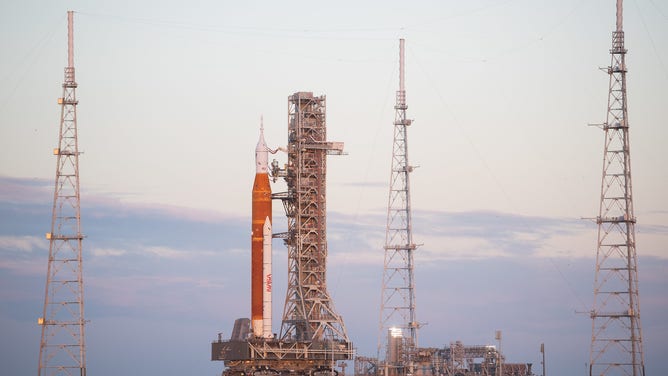Clock ticking on NASA's moon rocket lifespan
Many of the lifespan deadlines on NASA's Space Launch System rocket are due to wear and tear or safety requirements for hardware. NASA is targeting Nov. 16 for the next Artemis 1 launch attempt.
Tropical Storm Nicole could delay NASA's Artemis 1 launch
Florida is preparing for impacts from Tropical Storm Nicole. The system will soak the Space Coast and bring hurricane-strength winds near where NASA's Artemis 1 rocket is awaiting liftoff.
Since assembly began on NASA's mega moon rocket, a clock has been ticking on just how long the Space Launch System rocket can stay on this Earth before the space agency needs to make requests to extend safety deadlines in place on the moon rocket hardware.
Like most things in life, rocket parts also have an expiration date. As NASA prepares for the third Artemis 1 launch attempt in November, there are some upcoming lifespan milestones the space agency will have to watch.
Many of the deadlines on the SLS are due to wear and tear. Weighing about 5.75 million pounds, the SLS has been fully stacked with the Orion spacecraft since October 2021.
NASA's first attempt to launch the Artemis 1 mission was Aug. 29.
Extensions granted for fueling and solids rocket boosters
To reach orbit, NASA's moon rocket uses a core stage with RS-25 engines and two side solid rocket boosters, or SRBs, to produce 8.8 million pounds of thrust at liftoff.
The 177-foot-tall SRBs built by Northrop Grumman weigh about 1.6 million pounds apiece and have been stacked since March 2021, according to NASA.

In March 2021, stacking was completed for the left and right Space Launch System (SLS) solid rocket boosters for NASA’s Artemis I test flight. (Image Credit: NASA/Isaac Watson)
(NASA / NASA)
Ahead of NASA's next attempt to launch the SLS and Orion spacecraft on the Artemis 1 test flight around the moon, NASA managers confirmed the lifespan of the solid rocket boosters is set to expire in December.
"When you stacked your first segment on the AFT segment, you start a clock. That was at originally 12 months, and it's currently been analyzed up to 23 months," said Cliff Lanham, KSC Ground System senior vehicle operations manager. "One piece expires on the 9th of December of this year, and the other one is the 14th of December of this year."
WHAT IS NASA'S ARTEMIS 1 MISSION GOING TO DO?
That limited lifespan could be extended again, said Jim Free, associate administrator for NASA Exploration Systems Development Mission Directorate.
The SLS's orange core stage built by Boeing can only be fueled with supercold propellant so many times. Initially, that number was around nine times, but after a reevaluation, NASA said the core stage could be fueled about twice as many times as the original constraint.
The core stage has already been tanked with liquid hydrogen and liquid oxygen fuel four times at Kennedy Space Center for launch attempts or testing. Before it arrived in Florida, the core stage was also fueled with 700,000 gallons of cryogenic fuel at NASA’s Stennis Space Center in Mississippi for two hot fire tests during which the RS-25 engines were fired up.
Extended battery life on flight termination system
Another SLS hardware deadline is because of safety. Once the SLS is on the launchpad, the clock starts ticking on the certification of the flight termination system, which ensures if the rocket were to veer off course, it would detonate and not harm the public. A flight termination system (FTS) is required on all rockets.
The SLS was rolled out to Kennedy Space Center launchpad 39B on Nov. 4 ahead of the latest launch attempt.

NASA’s Space Launch System (SLS) rocket with the Orion spacecraft aboard is seen atop the mobile launcher as it arrives at Launch Pad 39B, Friday, Nov. 4, 2022, at NASA’s Kennedy Space Center in Florida. Photo Credit: (NASA/Joel Kowsky)
(NASA)
Per the U.S. Space Force, the flight termination system batteries have a 25-day lifespan before those need to be replaced. NASA was granted a waiver in September to extend that deadline while the agency attempted to launch the rocket again, but due to Hurricane Ian, the SLS was rolled back into the Vehicle Assembly Building. While in the hangar, the batteries were replaced and are now good for another 25 days.
In September, NASA's SLS chief engineer John Blevins told reporters that FTS batteries are located on each stage of the rocket, but the "heart of the system" is the bright orange SLS core stage.
After delaying the next launch attempt due to Tropical Storm Nicole, NASA is targeting Nov. 16 to try for a third time to launch the SLS and Orion on the Artemis 1 test flight. There are backup dates available in November and then again in December.
